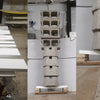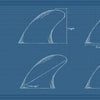UNDERSTANDING THE DIFFERENT TYPES OF TAIL DESIGNS

Surfboard tail could be a very complex subject to talk about, but we will try to make this as simple as we could by explaining basic theories that affect surfboards.
Tail designs are just one part of a whole surfboard but affect it greatly because this part of the board has a lot of contact with water, they affect the surface area and the outline shape. Keep in mind that one tail design could react completely differently if paired with different fins position, rocker curves, and foiling… So there is no absolute rule to this.
I approached my design first with an idea of what I wanted a board to do and feel, then I design all the features to complement each other to create a board that feel how I imagined it.
So, there are no features that work alone, and all have to work together like an orchestra.
I’m going to approach the subject in 3 different aspects:
- The effect of the tail on the outline
- Lift of the surface area and volume
- Water release
I would definitely look more in the general surface area and general outline of the rear half of a board when selecting a board than the last inches.
Some design help widen the board faster than other and create a staighter outline and more surface area, this will generally be faster with less control in fast waves and have more release.
Other design will help reduce surface area and create more control in faster waves or favorise making more curve to the outline to help transition rail to rail and turn.
That being said, lets check different tails design.
Square tail
Straighter outline – more lift and volume – water release freely.
Square tails usually maximize rail length, surface area in the tail, and water release at the tips.
The wider the square tail is the straighter the outline will be and it will maximize speed and lift.
This Tail design has full rail length, so if your board is 5’6’’ you have 5’6’’ of rail length. Longer rails usually mean longer arc turns on rails, but the increased surface area will force you to surf the board with your back foot further back to compensate for a lot of lift out of the tail and will allow you to pivot on your back foot in a tighter radius.
The hard edge of the square tail releases water easily and will provide more speed, but could also feel unstable.

Swallow tail
Straighter outline – good lift and volume – water release freely
Swallow tail has some of the same attributes as the square tail, but the removed area in the middle will create stability, bite on the wave face and reduce surface area. Swallow tails have made their proof over the years and are timeless. They offer the best attribute of a square tail and those of a pintail, making them a great all-rounder. If you want a board for most conditions fish tails are one of the best options. There is an infinite option to fish tails from retro fish to performance surfboards with swallow tails and each variable will be performing differently.

Diamond tail
Straighter outline – good lift and volume – water release freely
The diamond tail will reduce the rail length and reduce the area on the rail side those boards will be easier to go rail to rail and the reduced rail will help shorten the turn radius. The hard edge at the end will release water and the pin at the back will stabilize the board in drops. It is a good design option if you want to have a wide tail while keeping some stability.

Double bat tail
Straighter outline – good lift and volume – water release freely
This design will be really similar to the diamond tail but have more bite from the 5 tips in the back of the tail that will act as little pins tails that would still release in a controlled way.

Round tail
Rounder outline – less lift and volume – water sticks to the rail line
The round tail would offer a great balance of reliability, stability, lift, and release, but will tend to be slower than the previous options. This design is also good to go rail to rail.
The water flow sticking to the round rail line will create some drag and stabilize the board. The reduced area of the tail will help to sink it in the water and go rail to rail. The rounder outline will help the board turn on rail.

Pin Tail
Parallel outline – less lift and volume – water sticks to the rail line
Pin tails usually are for bigger waves and tend to offer the best stability for down-the-line speed and create longer arc turn. This design is great to go rail to rail.

In the end, the one thing to remember is that tail desing have to match the board purpose and be part of a whole. You could make a square tail board feel super stiff or super loose just by changing fins positions and you could make a round tail super fast with the right rocker, foiling and outline. So there is no one rules and you should think always of where you are surfing and the feel you want. Then look for a whole design that match what you want to acheive.
References:




